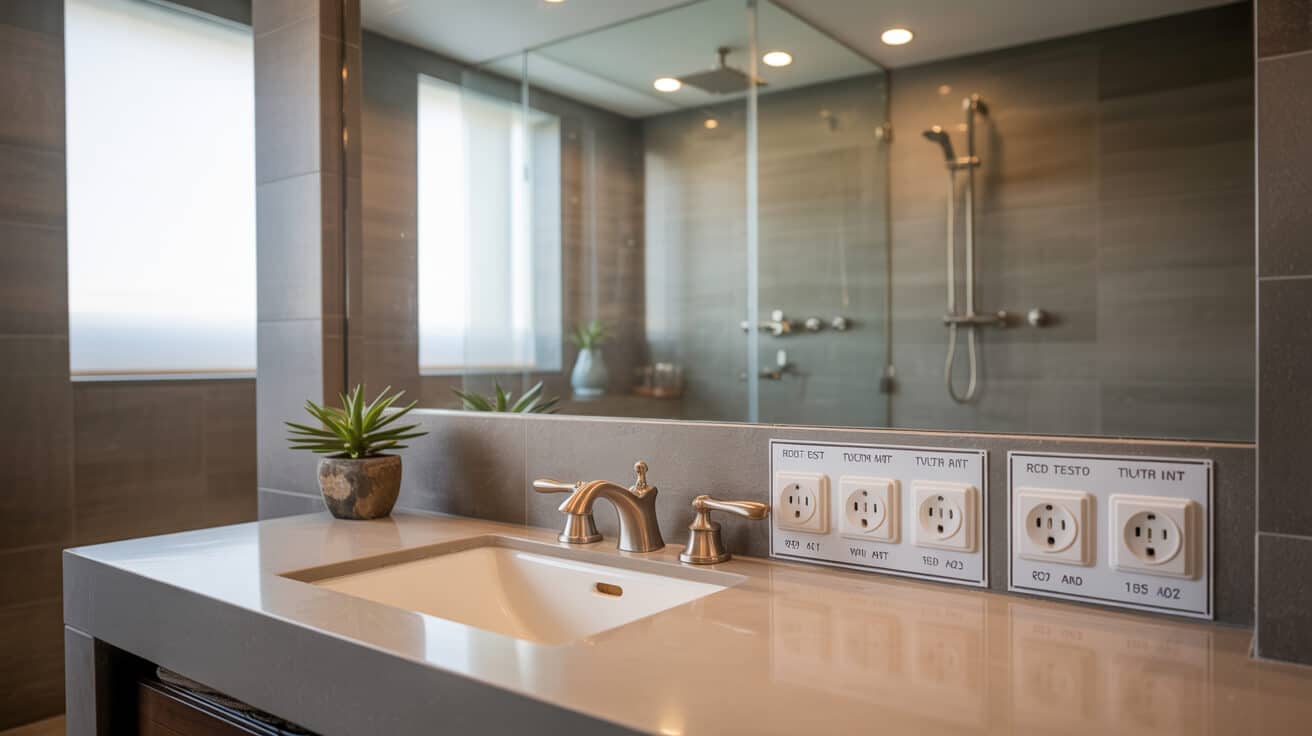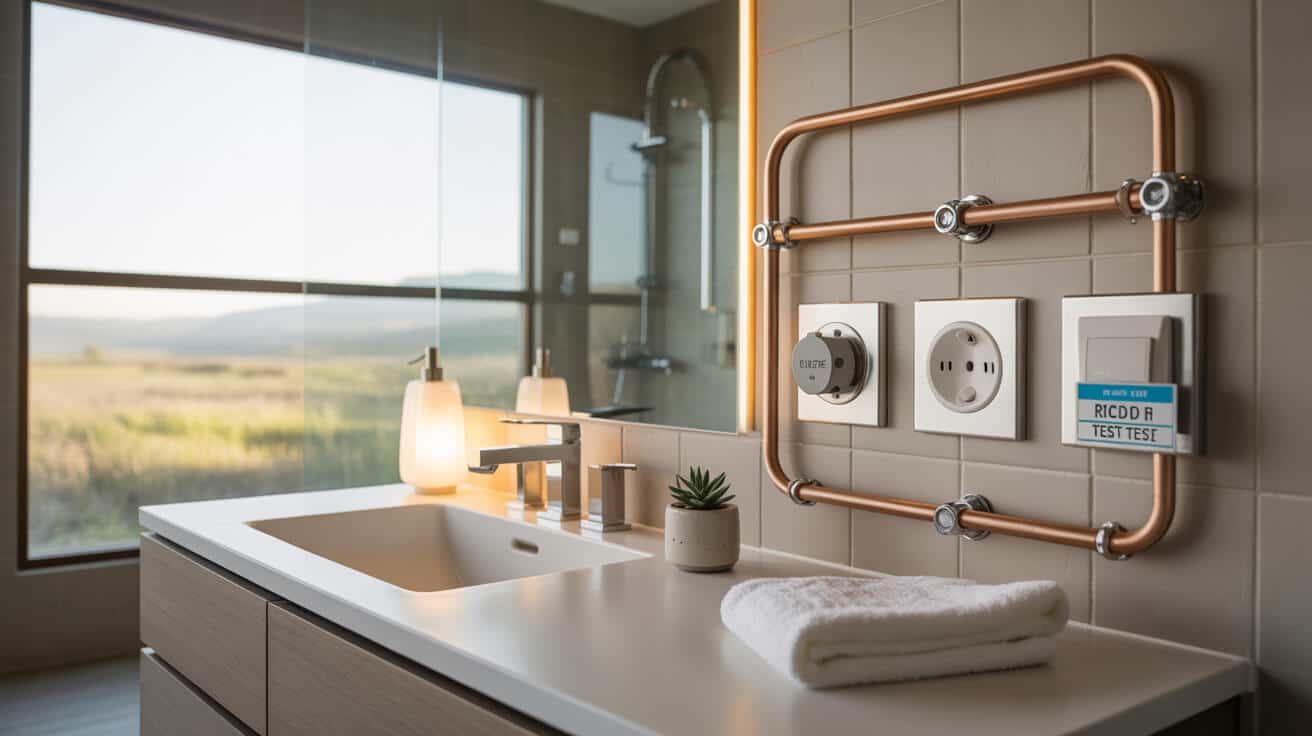Compliance with Part P is a legal obligation for anyone performing fixed electrical work in areas such as kitchens, bathrooms, and central heating systems, especially where water contact or steam elevates risk. The regulation defines notifiable and non-notifiable activities, prescribes documented standards for competence, and delineates how certification and statutory reporting should occur throughout your project or your organisation’s operation. Businesses such as Plumbers 4U incorporate these practices as core elements of responsible installation and guarantee services.
Part P refers to a key section within the Building Regulations for England and Wales, obligating that specific electrical installation work in dwellings meets recognised safety requirements. The regulation intersects directly with the plumbing and heating sector, where the installation and maintenance of devices like electric showers, immersion heaters, and unvented hot water cylinders often require new circuits, additional controls, or industry-approved connections. Whether you are a property owner planning renovations, a landlord managing multiple assets, or a facilities manager overseeing compliance, understanding Part P is fundamental to maintaining the safety, legality, and insurability of your premises. For companies like Plumbers 4U, adherence involves rigorous qualification tracking, process transparency, and a commitment to ongoing staff training.
Etymology or name origin
The “Part P” designation derives from the compartmentalised structure of the Building Regulations, which assign specific safety and performance domains (such as structure, fire, or sanitation) to individual sections, or “Parts.” Part P was introduced in 2005 amidst growing concern over domestic electrical accidents and was shaped to handle unique risks posed by water and electrical systems installed in proximity. The nomenclature reflects its position as the principal legal touchstone for electrical safety in dwellings and buildings where plumbing or heating installations amplify electrical risks.
Overview and context
Regulatory framework
Part P exists within the Building Regulations for England and Wales, setting minimum standards across the construction and service industry spectrum. Its primary scope is to ensure that people in domestic properties are protected from injury and property from damage as a direct or indirect result of electrical faults. Part P achieves this through a combination of competence-based regulation, notification requirements for higher-risk activities, and a certification regime accessible via both Local Authority Building Control and accredited Competent Person Schemes.
Scope within building services
The regulation is relevant to all electrical installation work connected to fixed wiring systems in dwellings as well as connected outbuildings, communal hallways in blocks of flats, certain commercial spaces, and occasionally rural properties. Within plumbing and heating, this includes any activity where you may introduce, modify, or extend an electrical supply: from connecting a new underfloor heating zone, to wiring a bathroom extractor, to commissioning a replacement central heating pump.
Relevance to plumbing and heating practitioners
For contractors and their clients, Part P injects legal force and technical discipline into daily work routines, mandating careful risk assessment and scrupulous record-keeping for any job involving the intersection of water and electrical installations. Engineers, plumbers, and heating specialists must often collaborate with registered electricians or maintain dual accreditation, ensuring all interventions provide both immediate safety and documented long-term value for the property. As professionals, you face both an oversight system and a market expectation that regulatory compliance is not only good practice but a baseline for trusted service.
Notifiable versus non-notifiable work
Electrical work is classified as “notifiable” when it either impacts circuit structure (e.g., new circuits, consumer unit alterations), occurs in high-risk zones (e.g., bathrooms, outdoors), or involves the installation of fixed electrical appliances in such areas (e.g., electric showers or pumps). Non-notifiable work includes straightforward repairs, like-for-like replacements outside of designated risk zones, and certain minor additions. Your exposure as a customer or asset manager depends on correctly classifying works at project outset—a process routinely managed by companies such as Plumbers 4U.
History
Early regulations and safety context
Before the formalisation of Part P, there was no statutory requirement for electrical work in domestic settings to be independently inspected or officially documented. A combination of technical guidance and voluntary codes covered the industry, but frequent incidents—including shock injuries and property fires attributed to poor wiring—exposed the consequences of unregulated installation, especially in conjunction with water-based systems.
Implementation in Building Regulations
Part P was incorporated into the Building Regulations after a government review highlighted disproportionate hazards from improper electrical work in dwellings. The initial roll-out in 2005 made it illegal to perform covered activities without notification to the local authority or registration with a Competent Person Scheme. Follow-up amendments in 2010 and periodic updates have clarified notifiable activities and created a pathway for industry-led self-certification.
Key changes and contemporary reforms
Further changes introduced streamlined notification protocols, digital reporting to Building Control, and increased penalties for non-compliance or the use of unverified (unregistered) labour. As installer roles evolved, multi-trade qualification schemes and expanded Competent Person Schemes broadened pathways for compliance. The 18th Edition of the Wiring Regulations (BS 7671) and the growing prevalence of modular control systems have updated technical requirements in sync with advances in building technology.
Industry adaptation and case examples
Property surveys and sales now routinely trigger documentation audits, uncovering legacy compliance shortfalls or missing certificates. Companies such as Plumbers 4U embed compliance as a core philosophy, incorporating multi-tiered staff training, audits, and digital record management, ensuring successful handover during property sale or transfer. Notable enforcement cases—where landlords faced fines or mandates due to missing Part P certificates, and where homeowners could not complete sales until remedial works were inspected—have further normalised adherence across the sector.

Concepts and definitions
Notifiable work
Notifiable work under Part P is any alteration, extension, or installation of new circuits in risk-prone conditions or environments, especially where water presents an elevated shock or fire hazard. This includes:
- New circuits in bathrooms or kitchens.
- Consumer unit changes.
- Wired installations of fixed appliances such as electric showers, towel rails, water heaters, and underfloor heating systems.
- Modifications in outdoor, wet, or communal areas in flats or multifamily dwellings.
Work falling outside these categories is generally non-notifiable, though all work must still conform to relevant standards.
Key safety principles
Safe engineering at the intersection of plumbing and electricity involves core practices such as:
- Earthing and equipotential bonding: Reducing risk by ensuring all exposed conductive parts share a low-resistance path to earth.
- Use of Residual Current Devices (RCDs): These protective systems rapidly disconnect a supply when leakage is detected, greatly reducing damage or shock potential.
- Safe isolation procedures: Systematic shutdown, tagging, and verification that a circuit is dead before any work commences.
- Zoning in special locations: Adhering to prescribed installation types and ratings in bathroom “zones” (0, 1, 2) where moisture and proximity combine to elevate risk.
Special locations
Bathrooms, shower rooms, wet rooms, and external installations are classified as special locations, each carrying tailored requirements for switching, outlet type, circuit protection, and allowable device positioning. Compliance in these zones routinely necessitates enhanced standards for insulation, ingress protection, and secondary protective measures.
Competent Person Schemes
Competent Person Schemes allow registered contractors to self-certify their compliance, bypassing the need for direct Building Control notification. Common schemes within the industry include NICEIC, NAPIT, ELECSA, and STROMA. Membership ensures that your work or your company’s projects are centrally logged, triggering documentation dispatch to both the property owner and the relevant building authority.
Applications and processes
Assessment and risk classification
Each project should begin with a risk and scope analysis to determine whether notification is required. Plumbers 4U and other certified companies typically provide you a detailed quotation that includes a compliance assessment, minimising risk of future insurance or resale problems.
Typical scenarios
Common works subject to Part P include:
- Installing or rewiring electric showers, central heating equipment, or immersion heaters.
- Adding underfloor heating circuits, bathroom extractor fans, or electric water pumps in wet areas.
- Extending ring mains, adding new points to kitchen or utilities circuits.
- Integrating smart thermostats or controls if fixed wiring changes are involved.
Certification and documentation
Any notifiable activity should result, on completion, in issuance of an Electrical Installation Certificate (EIC) or, for minor works, a Minor Electrical Installation Works Certificate. Notifications through Competent Person Schemes prompt automatic delivery of compliance certificates to both installation address and local authority. For projects managed more directly (non-registered contractors), you or your asset manager must apply to building control before commencing work and commission an accredited inspection or sign-off.
Notification pathways and timelines
A streamlined workflow encompasses:
- Project assessment
- Notification (pre- or post-, depending on route)
- Safe isolation and installation
- Testing and commissioning (including RCD performance, insulation resistance, earth continuity)
- Documentation and handover
Industry leaders, including Plumbers 4U, maintain efficient digital logbooks, ensuring repeatable compliance and transparent handover for complex or multi-phase projects.
Integration with project workflows
Fully compliant projects sequence notification and documentation in parallel with design, procurement, installation, and commissioning of mechanical plant. Clear boundaries between your electrical and plumbing professionals—unless dual-registered—are documented, supporting project risk management and clarity in contract deliverables.
Personnel and qualifications
Electrical qualification routes
Qualification levels necessary for notifiable electrical work begin at Level 3 in electrotechnical services, though many personnel attain higher certifications or specialist endorsements. For engineers and installers engaged mainly in plumbing or heating, additional short-course certifications are available, though these are increasingly limited to minor works and under the supervision of a registered electrician.
Defined roles
- Registered electricians: Authorised to perform all categories of work, notify directly, and self-certify.
- Multi-trade engineers: Often dual-registered; may partially complete installations but must refer out tasks beyond their scope.
- Supervisors and QSs: Ensure compliance, maintain documentation, and coordinate training or upskilling among teams.
CPD and training mandates
Competence in this domain is contingent on continuous professional development. Mandatory refresher programmes, product-specific updates (e.g., changes to RCD standards), and periodic scheme audits ensure that you and your organisation remain qualified to deliver services aligned with current regulations.
Systems, tools, and safety methodologies
Tools for safety and verification
Electrical safety tooling in this context includes:
- Insulation and continuity metres
- RCD testers
- Voltage testers and proving units
- Safe isolation lock-off kits
- Earth leakage detectors
- Calibration and test record logs
All tools must be externally calibrated, within date, and suitable for the voltage, current, and environmental rating of the system being tested.
Installation techniques
Documentation-driven installation processes, always integral to Plumbers 4U’s delivery, encompass:
- Pre-wiring surveys benchmarking system condition and hazard level.
- Use of armoured cable, waterproof enclosures, and protected routing in high-risk environments.
- Application of manufacturer and regulatory guidelines for circuit loadings, device locations, and secondary protection.
- Ongoing documentation before, during, and after works, using serialised logbooks, checklists, and photo records.
Devices and methodologies
Increasing device sophistication has transformed compliance: miniature residual current devices, switched fused connection units, and adaptive smart thermostats, when integrated correctly, can now enhance safety by supplementing core RCD/MCB protections.
Compliance management systems
Large-scale projects and repeated works for landlords or facility managers often benefit from digital compliance management solutions—combining e-certificates, inspection schedules, and automatic reminders for review or re-inspection.

Stakeholders and roles
Homeowners, occupiers, and clients
Property owners are ultimately responsible for retaining compliance certificates, seeking compliant professionals, and proactively managing the inspection and documentation process for all new installations. When engaging providers such as Plumbers 4U, you receive customer portal access to all compliance documentation.
Landlords and letting agents
Legal responsibility for compliance falls on both individual landlords and corporate letting agents. The Electrical Safety Standards in the Private Rented Sector (England) Regulations 2020 prescribe both periodic inspection cycles and mandatory documentation on commencement and completion of tenancies.
Developers and contract managers
For new builds or conversions, responsibility for compliance extends to main contractors, project managers, and the engineer of record. Failing to manage documentation or commissioning may delay completion certification or introduce post-handover liability for defects.
Contractors, sub-contractors, and trade teams
Each contractor or subcontractor must work within their documented competence, escalate gaps, and retain induction, inspection, or skills logs for audit.
Officials at the local level adjudicate notifiable work, sign off final installations, and may order correction where non-compliance is discovered in the survey or inspection cycle.
Legal, regulatory, and standards framework
Interface with Building Regulations
Part P operates within a cluster of safety and quality standards, linked to:
| Regulation / Standard | Domain | Cross-Impact |
|---|---|---|
| Part G | Sanitation, hot water supply | Water contact risk |
| Part H | Drainage, waste disposal | Hazard removal |
| Part L | Energy performance | system efficiency |
| Part M | Access, usability | Layout/final fit |
| BS 7671 | Electrical wiring | Technical reference |
| G3 certification | unvented cylinders | Plumbing + electric |
| WRAS | Water fixture compliance | Equipment approval |
Key wiring and installation standards
BS 7671 specifies the colour coding, quality, and technical performance requirements for all circuits. Amendments to these standards continually update the thresholds for RCD protection, cable sizing, IP ratings, and circuit design—parameters vital to safety in plumbing and heating installations.
Insurance and property transaction
Most mortgage and insurance providers require Part P certificates for relevant work before underwriting a new policy, settling a claim, or completing a sale. The absence of correct certificates can delay or prevent financial and legal processes associated with property transactions.
Penalties for non-compliance
Unlawful electrical work can result in local authority fines, mandatory rework, disqualification from Competent Person Schemes, or prosecution under health and safety law. For property managers and organisations, failed documentation audits can trigger compliance reviews or void insurance coverage.
Inspection, performance metrics, and documentation
Inspection and verification
Inspections test for:
- Proper device specification and siting (e.g., RCD rating)
- Cable routing, insulation, continuity, and earth fault loop impedance
- Proper zoning and protection in special locations
- Satisfactory completion per issued test certificate data
Common inspection findings
Table: Typical Defects and Remedies
| Defect | Typical Cause | Remedy |
|---|---|---|
| Lack of RCD protection | Legacy/mis-specified instal | Upgrade/main switch |
| Missing EIC/Minor Works Cert | Unregistered labour/oversight | Retrospective inspection |
| Circuit not isolated/segregated | Wiring extension without review | Circuit division and labelling |
| Device installed in wrong zone | Design/spec error | Relocation/new enclosure |
| Non-compliant bonding/earthing | Omitted or poor practice | Remedial bonding works |
Retention and disclosure
Property owners and asset managers should organise documentation chronologically, keeping original and digital copies of certificates, notification receipts, and inspection logs. Firms like Plumbers 4U provide cloud-based retrieval for your peace of mind.
Digital versus traditional management
The growing sophistication of compliance platforms enables easier searchability and sharing of records. Nonetheless, industry best practice remains the dual retention of paper and digital versions, especially when managing larger property portfolios.
Challenges and limitations
Technical barriers
Significant physical or technical challenges arise for properties with inaccessible cabling, high-density retrofit requirements, or incompatible legacy fixtures. Upgrading to current standards often means negotiating your asset’s limitations and weighing the value of incremental versus comprehensive works.
Barriers for contractors and property owners
Registration, training, and continuous professional development incur ongoing costs for both organisations and independent workers. Time investment for notification, inspection, and reporting can affect project delivery schedules for your company or tenants.
Increased compliance costs may initially price some customers out of routine upgrades, but the systematic benefits of reduced incidents, enhanced property value, and improved insurance positioning create indirect savings over time. Company transparency and issued certificates—standard practice at Plumbers 4U—are increasingly considered a minimum customer expectation.
Disputes and recourse
Regulatory complaints are resolved through local authority enforcement, Competent Person Scheme mediation, or, in serious cases, legal proceedings. Customers should expect service providers to maintain open communication, issue proactive compliance updates, and conduct regular review meetings when managing larger properties.
Impact and industry legacy
Accident reduction and safety improvements
Since its introduction, Part P has measurably lowered rates of electrical injury and accidental fire in residential contexts, particularly when combined with robust CPD and active monitoring by organisations like Plumbers 4U.
Public and industry trust
Published compliance records and transparent service protocols have redefined what property owners expect from domestic trades. Documentation now forms a substantive component of all resale, insurance, and rental interactions.
Market adaptation
The workforce has upskilled in documentation management, risk assessment, and system testing, with forward-looking companies investing in systems to anticipate regulatory evolution and align with shifting risk profiles in new construction techniques and products.
Case studies
Observed legal interventions, from court fines to remediation orders, highlight the need for clear accountability and prompt upkeep of certification records by stakeholders at every level.
Future directions, cultural relevance, and design discourse
The evolution of Part P and related frameworks is characterised by ongoing refinement in protective technology, stakeholder education, and policy. As customer expectations shift toward transparency and digital accessibility, organisations are deploying cloud-based compliance tracking, modular documentation, and cross-disciplinary upskilling to streamline delivery and audit readiness.
Technological improvements such as more sensitive protection devices, adaptive system monitoring, and standardised compliance protocols are likely to increase your property’s safety and asset value. Organisations embracing these changes position themselves at the forefront of professional trust and reliability in an ever-complex built environment.
Continued alignment of trade, regulatory, and consumer interests suggests that the definition of competent service in plumbing and heating will increasingly hinge on rigorous, demonstrable compliance—an ethos that underpins the service philosophy at Plumbers 4U and progressive firms in the field.

